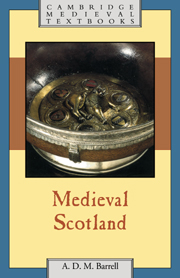Book contents
- Frontmatter
- Contents
- List of figures
- Preface
- List of abbreviations
- Maps
- 1 Early medieval Scotland
- 2 Feudal Scotland
- 3 The transformation of the Scottish church
- 4 The consolidation of the Scottish realm
- 5 The Wars of Independence
- 6 The Stewart kings
- 7 Crown and nobility in later medieval Scotland
- 8 The road to Reformation
- Conclusion
- Select bibliography
- Index
- Title in the Series
4 - The consolidation of the Scottish realm
Published online by Cambridge University Press: 05 June 2012
- Frontmatter
- Contents
- List of figures
- Preface
- List of abbreviations
- Maps
- 1 Early medieval Scotland
- 2 Feudal Scotland
- 3 The transformation of the Scottish church
- 4 The consolidation of the Scottish realm
- 5 The Wars of Independence
- 6 The Stewart kings
- 7 Crown and nobility in later medieval Scotland
- 8 The road to Reformation
- Conclusion
- Select bibliography
- Index
- Title in the Series
Summary
The development of the Scottish state cannot be explained solely in terms of institutional and ecclesiastical changes, but must be viewed also from the standpoint of the kings' relations both with external powers such as England and Norway and with semi-independent potentates within the frontiers of the realm itself. Around 1100 large parts of Scotland were effectively beyond the authority of the king, and the incorporation of Moray, Ross, Argyll and Galloway, and ultimately of the Hebrides, was to be a major theme of Scottish history well into the thirteenth century, although control of the more peripheral regions was frequently elusive even into the early modern period. Consolidation of their own position within Scotland, and of Scotland's status in the wider European world, were complementary objectives of the kings of the Canmore dynasty.
The notion that England and Scotland were continuously at war during the Middle Ages is deeply embedded in popular consciousness. In the period before the Wars of Independence, however, relations between the two states were often peaceful, a point which is emphasised by the relatively small number of castles in the frontier regions. This was partly a result of frequent marriages between members of the respective royal lines, but more especially because king and barons alike belonged to an international aristocracy, where relationships were determined by feudal bonds.
- Type
- Chapter
- Information
- Medieval Scotland , pp. 67 - 91Publisher: Cambridge University PressPrint publication year: 2000



